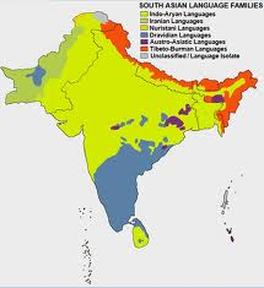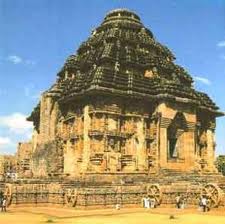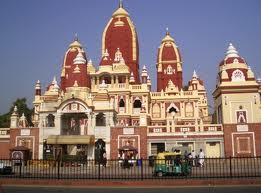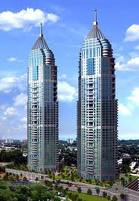HISTORY OF INDIAN SETTLEMENT
INTRODUCTION AND HISTORY

Aryan languages are in yellow while Dravidian languages are blue.
The Indus Valley civilization, one of the world's oldest, flourished during the 3rd and 2nd millennia B.C. and extended into northwestern India. Aryan tribes from the northwest infiltrated onto the Indian subcontinent during about 1500 B.C., and their merging with the earlier Indian inhabitants-the Dravidians, created the classical Indian culture. The Maurya Empire of the 4th and 3rd centuries B.C. - which reached its zenith under leader Ashoka united much of South Asia. The Golden Age, started by the Gupta dynasty from 4th to 6th centuries A.D. saw a fruitful boom in the areas of Indian science, art, and culture. Islam spread across the subcontinent over a period of 700 years. In the 10th and 11th centuries, Turks and Afghans invaded India and established the Delhi Sultanate. In the early 16th century, the Emperor Babur established the Mughal Dynasty which ruled India for more than three centuries. European explorers began establishing footholds in India during the 16th century. By the 19th century, Great Britain had become the dominant political power on the subcontinent. Nonviolent resistance to British rule, led by Mahatma Gandhi, eventually brought about independence in 1947. Communal violence led to the subcontinent's bloody partition, which resulted in the creation of two separate states, India and Pakistan. The two countries have fought three wars since independence, the last of which in 1971 resulted in East Pakistan becoming the separate nation of Bangladesh. (Central Intelligence Agency, 2010)
Interaction Between Aryans and Dravidians
The Aryans infiltrated India from areas to the north-west of the subcontinent. They were based in areas around the Fertile Crescent and parts of the population broke off and migrated to India. They battled the previously settled Dravidians and pushed them further and further south to the tip of the subcontinent, in which the land was not as rich or fertile. As the cultures evolved, many elements of both cultures were integrated into each other creating the complex and unique Indian cultures that still exist today (Central Intelligence Agency, 2010)
Modern Day Aryans

The modern day descendents of the Aryans live in the Northern and central parts of India. The derivative of the modern day Indo-Aryan languages is Sanskrit, which is rarely spoken today, but the most spoken language in India, Hindi, is one of it`s children. Some other languages that are derived from Sanskrit are Urdu, Bengali, and Punjabi. The picture to the left shows the areas of Aryan dominance highlighted in red(ethnicity of people and language spoken). One significant difference is that their culture has been much more deeply influenced by Western society than the Dravidian culture and this is evident in their music. Hindustani music, native to Hindi and Urdu peoples, have now evolved with forms mixing Western and Hindustani music together forming a music called fusion. (Central Intelligence Agency, 2010)
Modern Day Dravidians

The majority of the Dravidian culture originated in the Indian subcontinent and were pushed south by the Aryans who were stronger by number. The dominant language of the Dravidian culture was tamil, a language that still exists today, and many modern day Indian languages originated form Tamil are spoken in the Indian peninsula today including Telugu, Malayalam, and Kannada. Most of these languages are spoken in the southern parts of India, the areas highlighted in red show where modern as much, and Carnatic music, which is native to Dravidian people, has minimal western influence.Dravidian languages are spoken. As mentioned earlier, Western culture has not influenced modern day Dravidian descendents. (Wikipedia-Dravidians).
LARGEST INDIAN CITIES TODAY
· India is one of the most densely populated countries in the world and is home to many multi-million populationed cities. A vast variety of languages are also spoken in each of these cities. A list of the largest cities in India listing their populations.
1) Mumbai (Bombay)-16,368,000
2) Kolkata (Calcutta)-13,217,000
3) Delhi-12,791,000
4) Chennai-6,425,000
5) Bangalore-5,687,000
(Indian Government)
1) Mumbai (Bombay)-16,368,000
2) Kolkata (Calcutta)-13,217,000
3) Delhi-12,791,000
4) Chennai-6,425,000
5) Bangalore-5,687,000
(Indian Government)









